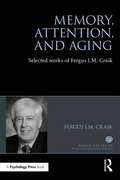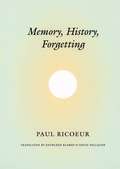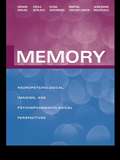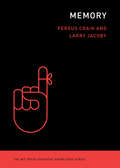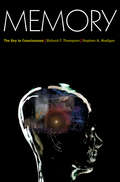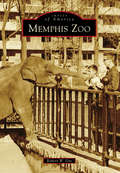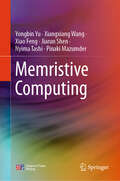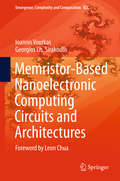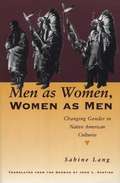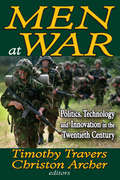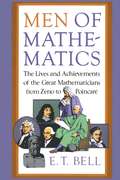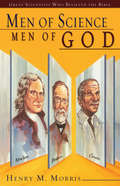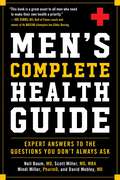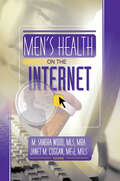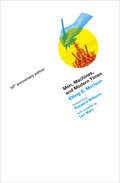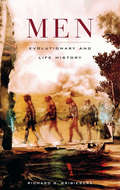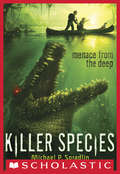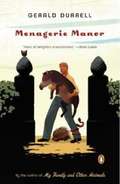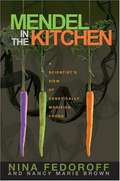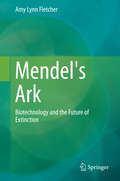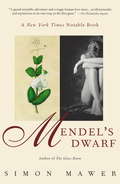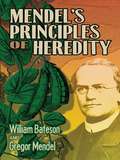- Table View
- List View
Memory, Attention, and Aging: Selected Works of Fergus I. M. Craik (World Library of Psychologists)
by Fergus I. CraikMemory, Attention, and Aging is a collection of some of the most influential journal articles previously published by Fergus Craik and his collaborators, with new introductory material unifying the research of this noted cognitive psychologist. The reprinted articles are grouped into six sections reflecting Craik’s various research interests across his career. The first section on short-term memory focuses on research concerns Craik uncovered in the 1970s, but are still valid today. They comprise theoretical suggestions and data on the nature of STM, including the notion that working memory may be defined as attention paid to features of items held in conscious awareness. The second section on levels of processing contains the very influential articles by Craik & Lockhart and by Craik & Tulving on memory research, in addition to a later article in which Craik gives a critical account of the LOP work. Craik’s third interest is in cognitive aging. The section contains two articles from the 1980s in which Craik lays out his ideas on age-related changes in memory, plus a more recent article addressing lifespan changes in cognition. The fourth section on attention and memory has two articles that report on the effects of divided attention on subsequent memory, and differences between implicit and explicit memory processes. The fifth section on cognitive neuroscience includes an early PET study probing neural correlates of LOP, and a study searching for the neural correlates of the "self" concept. Finally, the sixth section contains an article on bilingualism that explores age-related differences in executive functions as a consequence of bilingualism, and a study showing that bilingualism postpones the onset of Alzheimer’s disease. Grouping the most highly cited and groundbreaking articles of Fergus Craik in one volume, this book will be of interest to a wide spectrum of students and professional researchers.
Memory, History, Forgetting
by Paul RicoeurWhy do major historical events such as the Holocaust occupy the forefront of the collective consciousness, while profound moments such as the Armenian genocide, the McCarthy era, and France's role in North Africa stand distantly behind? Is it possible that history "overly remembers" some events at the expense of others? A landmark work in philosophy, Paul Ricoeur's Memory, History, Forgetting examines this reciprocal relationship between remembering and forgetting, showing how it affects both the perception of historical experience and the production of historical narrative.Memory, History, Forgetting, like its title, is divided into three major sections. Ricoeur first takes a phenomenological approach to memory and mnemonical devices. The underlying question here is how a memory of present can be of something absent, the past. The second section addresses recent work by historians by reopening the question of the nature and truth of historical knowledge. Ricoeur explores whether historians, who can write a history of memory, can truly break with all dependence on memory, including memories that resist representation. The third and final section is a profound meditation on the necessity of forgetting as a condition for the possibility of remembering, and whether there can be something like happy forgetting in parallel to happy memory. Throughout the book there are careful and close readings of the texts of Aristotle and Plato, of Descartes and Kant, and of Halbwachs and Pierre Nora. A momentous achievement in the career of one of the most significant philosophers of our age, Memory, History, Forgetting provides the crucial link between Ricoeur's Time and Narrative and Oneself as Another and his recent reflections on ethics and the problems of responsibility and representation.“His success in revealing the internal relations between recalling and forgetting, and how this dynamic becomes problematic in light of events once present but now past, will inspire academic dialogue and response but also holds great appeal to educated general readers in search of both method for and insight from considering the ethical ramifications of modern events. . . . It is indeed a master work, not only in Ricoeur’s own vita but also in contemporary European philosophy.”—Library Journal “Ricoeur writes the best kind of philosophy—critical, economical, and clear.”— New York Times Book Review
Memory: Neuropsychological, Imaging and Psychopharmacological Perspectives
by Gérard Emilien Cécile Durlach Elena Antoniadis Martial Van der Linden Jean-Marie MaloteauxMemory: Neuropsychological, Imaging and Psychopharmacological Perspectives reviews critically the impact of recent neuropsychological and biological discoveries on our understanding of human memory and its pathology. Too often, insights from clinical, neurological and psychopharmacological fields have remained isolated and mutually unintelligible. Therefore the first part of this book provides both clinicians and neuroscientists with a broad view of the neuropsychology of memory, and the psychobiological processes it involves, including recent advances from imaging technology and psychopharmacology research. In the second part the authors go on to cover a comprehensive range of memory assessments, dysfunctions, impairments and treatments. This compendium of current research findings will prove an invaluable resource for anyone studying, researching or practising in the field of memory and its disorders.
Memory: Selected Works Of Fergus I. M. Craik (The MIT Press Essential Knowledge series)
by Fergus Craik Larry JacobyA short, accessible primer on human memory, its workings, feats, and flaws, by two leading psychological researchers.Why do we vividly recall a traumatic childhood event but forget where we left our keys five minutes ago? How can a scent take us back fifty years while a colleague&’s name eludes us? In this compact introduction, two leading psychological researchers describe memory—how it works and why it sometimes doesn&’t; how it can be tricked, trained, or improved; and what changes with time. In a manner as engaging as it is informative, Fergus Craik and Larry Jacoby explain the strengths and weaknesses of memory. They trace evolving ideas about memory&’s function and present a down-to-earth account of modern views. Citing the latest research, they outline the processes for acquiring and retrieving memories and explore the distinction between conscious and unconscious processes. With insights into the workings of the brain, Craik and Jacoby also provide a succinct account of feats and failures of memory, emotion and false memories, and the effects of aging. Their book draws a clear picture, at once broad and concise, of current and classical views of memory, that most essential and often mysterious feature of human life.
Memory: The Key To Consciousness
by Richard F. Thompson Stephen A. MadiganMemory is perhaps the most extraordinary phenomenon in the natural world. Every person's brain holds millions of bits of information in long-term storage. This vast memory store includes our extensive vocabulary and knowledge of language; the tremendous and unique variety of facts we've amassed; all the skills we've learned, from walking and talking to musical and athletic performance; many of the emotions we feel; and the continuous sensations, feelings, and understandings of the world we term consciousness. Without memory there can be no mind as we understand it. Focusing on cutting-edge research in behavioral science and neuroscience, Memory is a primer of our current scientific understanding of the mechanics of memory and learning. Over the past two decades, memory research has accelerated and we have seen an explosion of new knowledge about the brain. For example, there now exists a wide-ranging and successful applied science devoted exclusively to the study of memory that has yielded better procedures for eliciting valid recollections in legal settings and improved the diagnosis and treatment of memory disorders. Everyone fascinated by the scope and power of the human brain will find this book unforgettable.
Memphis Zoo
by Robert W. DyeWhat started over a century ago with an orphaned bear tied to a tree in Overton Park has grown into one of the nation's top zoos. The Memphis Zoo, which attracts more than one million visitors each year, is nationally recognized not only as a tourist attraction but also for its giant panda research, captive breeding programs, and efforts to reintroduce endangered species into the wild. Established in 1906 by the Memphis Park Commission, the zoo has become a Memphis institution. It seems like everyone in Memphis has an Elvis story, but just as many Memphians have memories of the zoo and attractions like the Lion House, Monkey Island, or the free one-ring circus. The zoo has been fortunate to have many devoted staff members and volunteers over the years, and through hard work and dedication, they have built a first-class institution--not only for the animals but for the families, children, and all patrons who visit the zoo every day.
Memristive Computing
by Pinaki Mazumder Xiao Feng Yongbin Yu Xiangxiang Wang Jiarun Shen Nyima TashiThis book delves into a wide array of topics, ranging from memristor and its emulator to chaotic circuits based on memristor, memristor-based en/decryption systems, filter design based on memristive family, memristive filter for signal processing, memristor network-based swarm intelligence, dynamic analysis of memristive neural networks, and the application of memristor-based neural networks. It provides a comprehensive and systematic exploration of how memristors empower and drive cutting-edge research in neuromorphic computing and artificial intelligence. This book encourages fostering interdisciplinary information literacy and cultivating cross-disciplinary computational thinking. This book plays a pivotal role in embracing and advancing the development of neuromorphic computing. Through profound foundational theories and academic analysis methods, this book guides artificial intelligence graduate students and engineering professionals in constructing a comprehensive knowledge and technological framework for memristor research.
Memristor-Based Nanoelectronic Computing Circuits and Architectures
by Ioannis Vourkas Georgios Ch. SirakoulisThis book considers the design and development of nanoelectronic computing circuits, systems and architectures focusing particularly on memristors, which represent one of today's latest technology breakthroughs in nanoelectronics. The book studies, explores, and addresses the related challenges and proposes solutions for the smooth transition from conventional circuit technologies to emerging computing memristive nanotechnologies. Its content spans from fundamental device modeling to emerging storage system architectures and novel circuit design methodologies, targeting advanced non-conventional analog/digital massively parallel computational structures. Several new results on memristor modeling, memristive interconnections, logic circuit design, memory circuit architectures, computer arithmetic systems, simulation software tools, and applications of memristors in computing are presented. High-density memristive data storage combined with memristive circuit-design paradigms and computational tools applied to solve NP-hard artificial intelligence problems, as well as memristive arithmetic-logic units, certainly pave the way for a very promising memristive era in future electronic systems. Furthermore, these graph-based NP-hard problems are solved on memristive networks, and coupled with Cellular Automata (CA)-inspired computational schemes that enable computation within memory. All chapters are written in an accessible manner and are lavishly illustrated. The book constitutes an informative cornerstone for young scientists and a comprehensive reference to the experienced reader, hoping to stimulate further research on memristive devices, circuits, and systems.
Men Against Fire: The Problem of Battle Command in Future War
by S. L. A. MarshallThis book examines why only one in four men in battle seem to fire their guns, and offers means by which the number of active soldiers can be increased.
Men as Women, Women as Men: Changing Gender in Native American Cultures
by Sabine LangAs contemporary Native and non-Native Americans explore various forms of "gender bending" and gay and lesbian identities, interest has grown in "berdaches," the womanly men and manly women who existed in many Native American tribal cultures. Yet attempts to find current role models in these historical figures sometimes distort and oversimplify the historical realities. This book provides an objective, comprehensive study of Native American women-men and men-women across many tribal cultures and an extended time span. As contemporary Native and non-Native Americans explore various forms of "gender bending" and gay and lesbian identities, interest has grown in "berdaches," the womanly men and manly women who existed in many Native American tribal cultures. Yet attempts to find current role models in these historical figures sometimes distort and oversimplify the historical realities. This book provides an objective, comprehensive study of Native American women-men and men-women across many tribal cultures and an extended time span. Sabine Lang explores such topics as their religious and secular roles; the relation of the roles of women-men and men-women to the roles of women and men in their respective societies; the ways in which gender-role change was carried out, legitimized, and explained in Native American cultures; the widely differing attitudes toward women-men and men-women in tribal cultures; and the role of these figures in Native mythology. Lang's findings challenge the apparent gender equality of the "berdache" institution, as well as the supposed universality of concepts such as homosexuality.
Men at War: Politics, Technology, and Innovation in the Twentieth Century
by Christon ArcherThe growing number of books on military history and the lively interest in military history courses at colleges and universities show that the study of war is enjoying considerable popularity. The reasons for this are arguable, but of immediate interest is the kind of military history that is taught and written. Here the student of war comes across an interesting division of opinion as to how military history should be written. Military history, lying as it does on the frontier between history and military science, requires knowledge of both fields. This fact often presents a difficulty to the history teacher.Generally speaking, history is a discipline by virtue of its subject matter, not by virtue of a particular methodology such as is characteristic of the sciences and of some social sciences. The perspective of Men at War is a cross between a professional internalist approach and a civilian contextual view. This separation is not unique to military history, for the same dualism tends to occur in those areas of history, such as law and medicine, that can be written both by members of the profession concerned lawyers and doctors and by those outside the profession.The problem is that at one extreme the contextual view can take the emotional content out of war, while at the other extreme the internalist view can put too much in. Men at War seeks to locate a military history that combines the professional, internalist method and the civilian, contextual method by showing that these are two fundamental sources from which a war derives. Seen in this way, this volume breaks new ground in defining the sources of twentieth-century power.
Men of Mathematics
by E. T. BellHere is the classic, much-read introduction to the craft and history of mathematics by E.T. Bell, a leading figure in mathematics in America for half a century. Men of Mathematics accessibly explains the major mathematics, from the geometry of the Greeks through Newton's calculus and on to the laws of probability, symbolic logic, and the fourth dimension. In addition, the book goes beyond pure mathematics to present a series of engrossing biographies of the great mathematicians -- an extraordinary number of whom lived bizarre or unusual lives. Finally, Men of Mathematics is also a history of ideas, tracing the majestic development of mathematical thought from ancient times to the twentieth century. This enduring work's clear, often humorous way of dealing with complex ideas makes it an ideal book for the non-mathematician.
Men of Science Men of God
by Dr Henry M. MorrisOne of the most serious fallacies today is the belief that genuine scientists cannot believe the Bible. THE TRUTH IS that many of the major scientific contributions were made by scientists who were dedicated men of God. In Men of Science, Men of God, Dr. Henry Morris presents 101 biographies which include Christian testimonies of scientists who believed in the Bible and in a personal Creator God . . . scientists who were pioneers and "founding fathers" of modern scientific disciplines. "This is a must for every Christian library, and should be required reading for students." - Baptist Bulletin Dr. Henry M. Morris is the father of modern Creation science, the founder of Institute for Creation Research (ICR) and the author of many well-known apologetic books. His thriving legacy continues to equip Christians to be able to defend the accuracy and authority of Scripture today.
Men's Complete Health Guide: Expert Answers to the Questions Men Don't Always Ask
by Scott Miller Neil Baum David Mobley Mindi Miller"This book is a great asset to all men who need to make their own health a priority." --Joe Gibbs, NFL Hall of Fame coach and owner of 4x NASCAR champion Joe Gibbs Racing Everything you need to know about men&’s health in one handy package—updated, revised, and expanded. The authors&’ first edition (2018) concentrated on the male pelvis and health concerns &“down there.&” Urologists Neil Baum and Scott Miller described the male pelvic region and its complex functions before moving on to a comprehensive list of related medical concerns, including pelvic pain, prostate problems, urinary leakage, urinary tract infections, testosterone deficiency, STDs, prostate cancer, and questions about infertility and sexual dysfunction. Both authors approached these very personal and sensitive topics with straightforward, reader-friendly language, using case examples, illustrations, research, and occasional humor to explain the potential causes and cures for each medical challenge. Five years later, the authorship has been doubled to include one more urologist, David Mobley, and a Doctor of Pharmacy, Mindi Miller. With this expanded team of experts, the goal is to provide men with health information—not only from prostate to penis—but from head to toe. Nine totally new chapters address a wide range of topics that altogether equip the reader with key information to assess and improve his mental, physical, and emotional health. The authors even provide step-by-step processes to use when selecting a doctor or surgeon, and what signs might indicate that a doctor&’s visit is a must. Men&’s Complete Health Guide means that men no longer need to suffer in silence or dwell in denial. This valuable resource enables every man to become his own health advocate, more likely to discuss body concerns with family or friends, and more open to seeking a doctor&’s advice for remedy.
Men's Health on the Internet
by Janet M CogganThe best health resources for men on the Net!Men's Health on the Internet puts the best of what the Web has to offer on the subject into one handy volume. Use it as a guide to the best Web sites representing men's health organizations, reliable sites where you can find current health news for men, and much more! This important book evaluates Web sites for content, clarity, and user-friendliness, and shows you how to conduct a focused, subject-specific search.From editor M. Sandra Wood: “It is well known that men are less likely than women to seek health care. Men tend to wait as long as possible to see a doctor about a health problem, making early diagnosis difficult if not impossible. Given the fact that men seem to be more private about their illnesses, the Internet provides an excellent place for them to seek health care information.”Men's Health on the Internet: examines what men need and expect as health care consumers provides an overview of the resources available on the World Wide Web teaches you about search engines and how to use them to find what you're looking for quickly and efficiently points you toward information on cancer--Web-based resources on risk factors, early detection, and treatment brings you reliable resources for information on prostate problems puts you in touch with reliable information men's concerns, including hair loss, high blood pressure (hypertension), heart health, infertility/impotence, and physical fitness includes resources for gay men's health issues increases your awareness of different types of Internet resources, including mailing lists, newsgroups, and real-time communication Information resources on the Internet relating to health issues, from Web sites to newsletters to chat groups, are abundant. Some are much more reliable than others, and there is just as much variety when it comes to ease of use. Take control--use Men's Health on the Internet to sift through the often overwhelming number of related sites to find the information you need!
Men, Machines, and Modern Times, 50th Anniversary Edition
by Elting E. MorisonAn engaging look at how we have learned to live with innovation and new technologies through history.People have had trouble adapting to new technology ever since (perhaps) the inventor of the wheel had to explain that a wheelbarrow could carry more than a person. This little book by a celebrated MIT professor—the fiftieth anniversary edition of a classic—describes how we learn to live and work with innovation. Elting Morison considers, among other things, the three stages of users' resistance to change: ignoring it; rational rebuttal; and name-calling. He recounts the illustrative anecdote of the World War II artillerymen who stood still to hold the horses despite the fact that the guns were now hitched to trucks—reassuring those of us who have trouble with a new interface or a software upgrade that we are not the first to encounter such problems.Morison offers an entertaining series of historical accounts to highlight his major theme: the nature of technological change and society's reaction to that change. He begins with resistance to innovation in the U.S. Navy following an officer's discovery of a more accurate way to fire a gun at sea; continues with thoughts about bureaucracy, paperwork, and card files; touches on rumble seats, the ghost in Hamlet, and computers; tells the strange history of a new model steamship in the 1860s; and describes the development of the Bessemer steel process. Each instance teaches a lesson about the more profound and current problem of how to organize and manage systems of ideas, energies, and machinery so that it will conform to the human dimension.
Men: Evolutionary and Life History
by Richard G. BribiescasMales account for roughly 50 percent of the global population, but in America and other places, they account for over 85 percent of violent crime. A graph of relative risk of death in human males shows that mortality is high immediately following birth, falls during childhood, then exhibits a distinct rise between the ages of 15 and 35—primarily the result of accidents, violence, and risky behaviors. Why? What compels males to drive fast, act violently, and behave stupidly? Why are men's lives so different from those of women? Men presents a new approach to understanding the human male by drawing upon life history and evolutionary theory. Because life history theory focuses on the timing of, and energetic investment in, particular aspects of physiology, such as growth and reproduction, Richard Bribiescas and his fellow anthropologists are now using it in the study of humans. This has led to an increased understanding of human female physiology—especially growth and reproduction—from an evolutionary and life history perspective. However, little attention has been directed toward these characteristics in males. Men provides a new understanding of human male physiology and applies it to contemporary health issues such as prostate cancer, testosterone replacement therapy, and the development of a male contraceptive. Men proves that understanding human physiology requires global research in traditionally overlooked areas and that evolutionary and life history theory have much to offer toward this endeavor.
Menace From the Deep (Killer Species #1)
by Michael P. SpradlinA brand-new action-packed series from Michael P. Spradlin. Each book covers a genetically engineered super predator wreaking havoc on the environment.Emmet Doyle is not in the best mood when he arrives in Florida City. His father is a wildlife biologist, and has been summoned to the Everglades, dragging Emmet along with him. Though still in mourning from losing his mom a year ago, Emmet's trying hard to keep a good attitude. Upon their arrival, however, things quickly get weird. Dr. Rosalita Geaux, the Park Superintendent, wastes no time in revealing the reason she called Emmet's father to Florida. A strange creature was recently found dead in the park, and upon seeing it, it becomes clear to everyone that this is not a native species. This is man-made.Deep in the swamp, someone has been experimenting to create a new breed of apex predator. And they're about to set them loose.
Menagerie Manor
by Gerald Durrell"Menagerie Manor" is sure to delight fans of Durrell's beloved classic "My Family and Other Animals" and other accounts of his lifelong fascination with members of the animal kingdom.
Mendel in the Kitchen: A Scientist's View of Genetically Modified Foods
by Nancy Marie Brown Nina FedoroffWhile European restaurants race to footnote menus, reassuring concerned gourmands that no genetically modified ingredients were used in the preparation of their food, starving populations around the world eagerly await the next harvest of scientifically improved crops. Mendel in the Kitchen provides a clear and balanced picture of this tangled, tricky (and very timely) topic. Any farmer you talk to could tell you that we have been playing with the genetic makeup of our food for millennia, carefully coaxing nature to do our bidding. The practice officially dates back to Gregor Mendel – who was not a renowned scientist, but a 19th century Augustinian monk. Mendel spent many hours toiling in his garden, testing and cultivating more than 28,000 pea plants, selectively determining very specific characteristics of the peas that were produced, ultimately giving birth to the idea of heredity - and the now very common practice of artificially modifying our food. But as science takes the helm, steering common field practices into the laboratory, the world is now keenly aware of how adept we have become at tinkering with nature - which in turn has produced a variety of questions. Are genetically modified foods really safe? Will the foods ultimately make us sick, perhaps in ways we can't even imagine? Isn't it genuinely dangerous to change the nature of nature itself? Fedoroff, a leading geneticist and recognized expert in biotechnology, answers these questions, and more. Addressing the fear and mistrust that is rapidly spreading, Federoff and her co-author, science writer Nancy Brown, weave a narrative rich in history, technology, and science to dispel myths and misunderstandings. In the end, Fedoroff arues, plant biotechnology can help us to become better stewards of the earth while permitting us to feed ourselves and generations of children to come. Indeed, this new approach to agriculture holds the promise of being the most environmentally conservative way to increase our food supply.
Mendel's Ark
by Amy Lynn FletcherDoes extinction have to be forever? As the global extinction crisis accelerates, conservationists and policy-makers increasingly use advanced biotechnologies such as reproductive cloning, polymerase chain reaction (PCR) and bioinformatics in the urgent effort to save species Mendel's Ark considers the ethical, cultural and social implications of using these tools for wildlife conservation Drawing upon sources ranging from science to science fiction, it focuses on the stories we tell about extinction and the meanings we ascribe to nature and technology The use of biotechnology in conservation is redrawing the boundaries between animals and machines, nature and artifacts, and life and death The new rhetoric and practice of de-extinction will thus have significant repercussions for wilderness and for society. The degree to which we engage collectively with both the prosaic and the fantastic aspects of biotechnological conservation will shape the boundaries and ethics of our desire to restore lost worlds.
Mendel's Dwarf
by Simon MawerIn this scientific novel, Dr Benedict Lambert works to unlock the secrets of heredity.
Mendel's Principles of Heredity
by William Bateson Gregor MendelSix years after Charles Darwin announced his theory of evolution to the world, Gregor Mendel began studying the inheritance of traits in pea plants. Mendel's research led to his discovery of dominant and recessive traits and other facts of evolution, which he reported in his groundbreaking 1865 paper, Experiments in Plant Hybridization. His findings languished until 1902, when William Bateson revived interest in the subject with this book, a succinct account of Mendel's heredity-related discoveries. Bateson coined the term "genetics" to refer to heredity and inherited traits, and his rediscovery of Mendel's work forms the foundation of today's field of genetics.Suitable for biology and general science students at the undergraduate and graduate levels, this volume is essential reading for anyone with an interest in science and genetics. In addition to Bateson's commentary, it features two of Mendel's papers--including the original Experiments--plus a biography of Mendel, a detailed bibliography, and indexes of subjects and authors. Numerous figures complement the text, along with eight pages of color illustrations.
Mendeleev on the Periodic Law: Selected Writings, 1869 - 1905 (Dover Books on Chemistry)
by William B. Jensen Dmitri Ivanovich MendeleevBy the dawn of the nineteenth century, "elements" had been defined as basic building blocks of nature resistant to decomposition by chemical means. In 1869, the Russian chemist Dmitri Ivanovich Mendeleev organized the discord of the elements into the periodic table, assigning each element to a row, with each row corresponding to an elemental category. The underlying order of matter, hitherto only dimly perceived, was suddenly clearly revealed.This is the first English-language collection of Mendeleev's most important writings on the periodic law. Thirteen papers and essays, divided into three groups, reflect the period corresponding to the initial establishment of the periodic law (three papers: 1869-71), a period of priority disputes and experimental confirmations (five papers: 1871-86), and a final period of general acceptance for the law and increasing international recognition for Mendeleev (five papers: 1887-1905). A single, easily accessible source for Mendeleev's principle papers, this volume offers a history of the development of the periodic law, written by the law's own founder.
